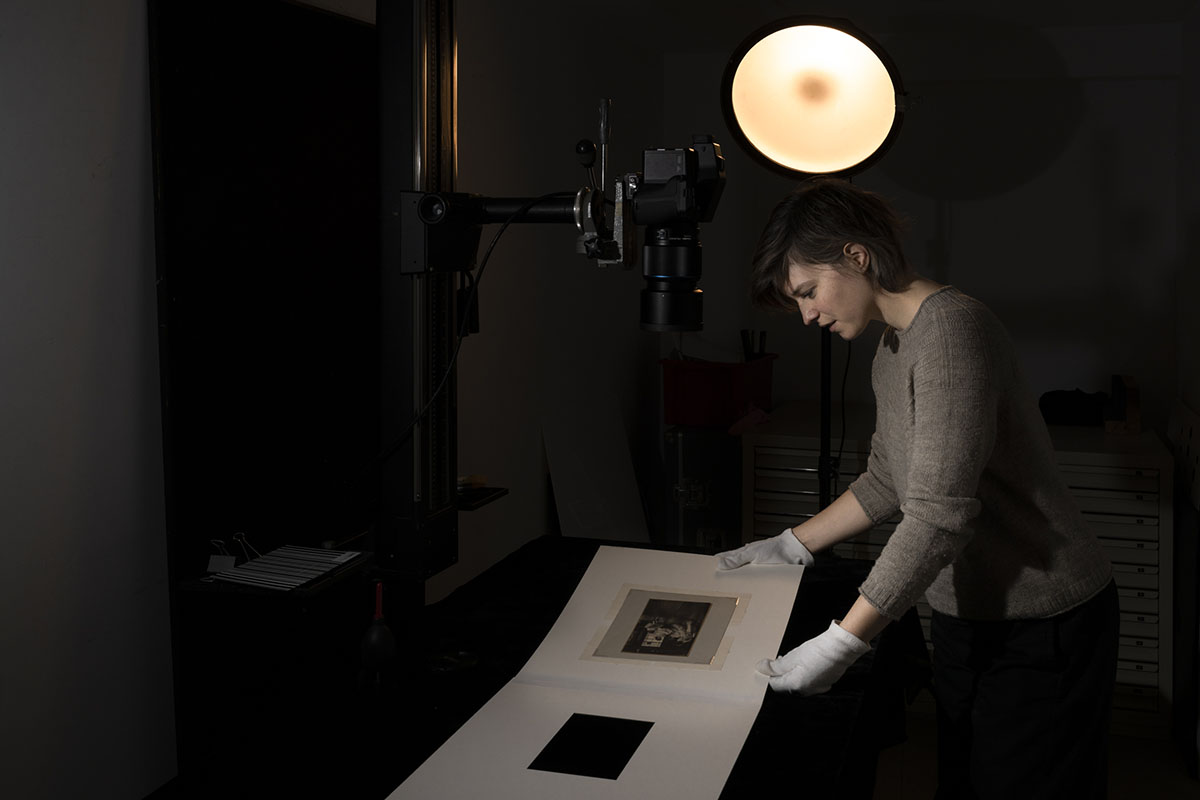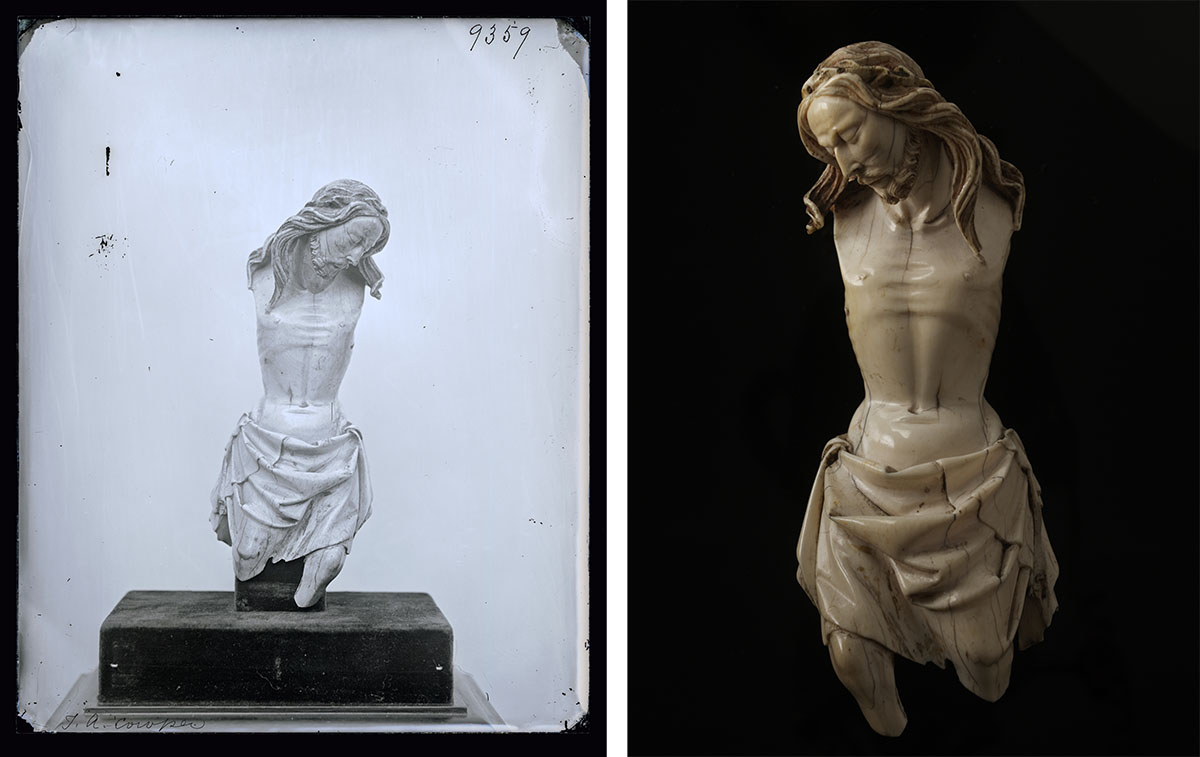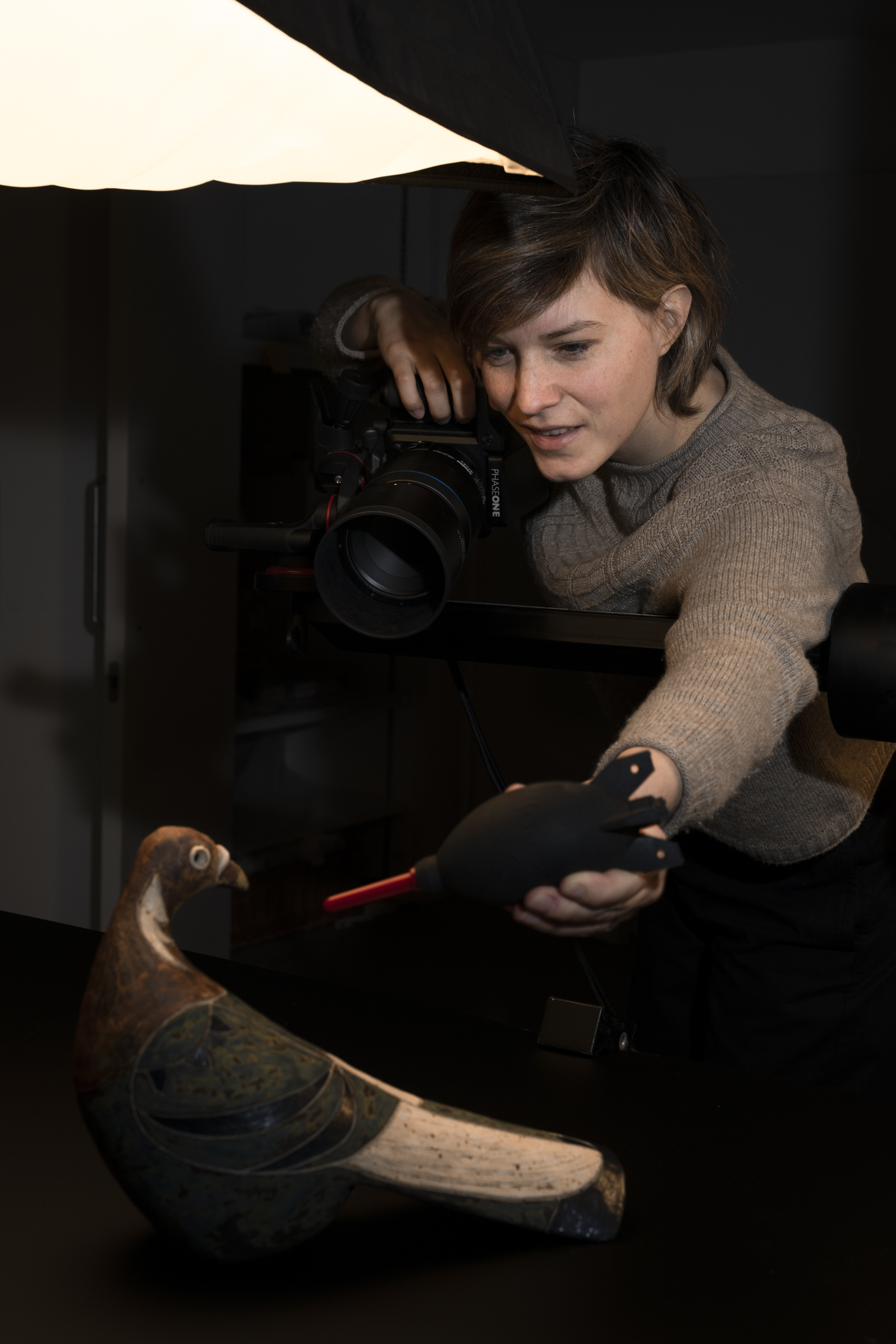To celebrate International Women’s Day, and the publication of What Photographs Do (an open-access publication from the V&A and UCL Press), we recorded this conversation between Erika Lederman (Cataloguer of Photographs) and Kira Zumkley (Head of Photography and Digitisation). Here they talk about Kira’s work now, and her precedents at the V&A.
Erika Lederman will be giving a Lunchtime Lecture on the work of Isabel Agnes Cowper on 9 March 2023. Find out more.
Erika Lederman
Perhaps we could begin by talking about how you came into museum photography? What’s the story behind how you got here?
Kira Zumkley
I studied archaeology for my bachelor’s degree, but during my studies I realised that it would be very hard to make a living as an archaeologist! I had done a bit of photography here and there, and thought it could set me apart from other archaeologists. So I moved to London to do a photography degree at LCC and, while doing that, I worked as a photography assistant and also interned at the British Museum – which is where I first encountered ‘museum’ photography.
Through one of photographers I worked for in London, I managed to get the contact details of the photography manager at the V&A, who agreed to let me intern here. Off the back of that, I got my first proper job as a museum photographer.
EL: It’s interesting for me to hear your story, because while Isabel Agnes Cowper (the V&A’s Official Museum Photographer in the 19th century) did not have the exact same trajectory, there are elements of your journey that are very similar to the way in which Cowper became a museum photographer. Like you, she was not specifically trained in photography. And like you, Cowper used her connections to forge her career, in her case, her family connections. As you probably know, Cowper’s brother, Charles Thurston Thompson was the V&A’s first official museum photographer, and when she became a widow, she acted as his assistant. When he died unexpectedly in 1868, through her connections and personal relationship to Henry Cole, she got the job.
KZ: Yes, starting out I thought that it was just hard work and good grades that would get me somewhere and I quickly learned it is often also about who you know. But I think thankfully that has changed in the last few years, with better guidance on recruitment practices.

EL: Exactly. Cowper was trained as a wood engraver through her family’s business, and that’s how she was introduced to Henry Cole. Cole was looking for people to create illustrations for the guidebooks that he was writing on Westminster Abbey. He hired Cowper and her sisters, also skilled engravers, to take on the work. Soon after, the technology for illustrating books changed from wood engraving to photography, and Cowper’s training in wood-engraving, including skills to read a woodblock in preparation for printing, similar to the way in which one interprets a photographic negative, prepared her for a career as a photographer. It made her extremely good at evaluating the quality of a negative.
KZ: I think there are a lot of people in the museum today who, like Cowper, bring additional skills to their work. Cowper’s technical background made her a better photographer, and I think my archaeological training helped me.
EL: So tell us what the responsibilities as Head of Photography and Digitisation are? Or perhaps outline a typical day.
KZ: My department is part of the Collections Care and Access Division, so we work closely with Conservation, Technical Services and Collection Management teams. We have requests coming in to photograph objects that are going on loan, or are needed for a publication, exhibition, or for our website. It’s my job to coordinate all of that.
I also set out our digitisation strategy and look at improving our services and procedures. Recently, I wrote our photography and digitisation policy, which outlines the technical quality we strive for as a Department.
We’ve also started looking into more advanced imaging services and recently created a 2D+ model of one of our objects using reflectance transformation imaging; essentially a way to visualize surface texture.
We are also exploring what we can do to enhance how our collection is documented. For example, with contemporary objects like a costume, we’re suggesting that we photograph it being worn, or captured behind the scenes. It would give the object a fuller context and future-proof it’s legacy in the collection.
EL: It’s interesting that these initiatives are being driven by the Photo Studio, and not from curatorial perspective or collections-based colleagues. Do you feel you have the authority to pursue these types of initiatives. And in terms of authority, do you feel that your gender has played a role in how you are able to do your job?
KZ: We do work very closely with our colleagues across the museum on these kinds of initiatives and I am in the lucky position that I have the support of my manager and the authority to pursue them. In regards to my gender playing a role … historically photography has been a very male space and in many areas, such as photojournalism that is still the case. Six years ago, of all the big museums, only the photography team at the National Gallery and Royal Museum of Greenwhich were managed by women. Now, the V&A, Science Museum, Tate, and the British Museum are also led by female photography managers and heads of departments.
EL: That’s extraordinary; even in Cowper’s time, you had a woman photographer at the Louvre, which at the time was called the Musée Napoleon III. Her name was Louise Laffon and she was taking photographs for various curatorial and publishing initiatives there. Jane Clifford was working at the Prado in Spain, documenting the Spanish Royal Collection. And it was not just art institutions where you might find female photographers, you also had a group of women taking photographs at the Royal Observatory at Greenwich, making images for the ‘carte du ciel’ project in the 1890s. In the 1870s You had a woman working at the Linnaeus Archive in Uppsala, Sweden. So from the earliest days of photography’s use in institutions, women have been there!
KZ: That’s brilliant. I didn’t realise so many women were engaged at that time. I think as a woman working in a technical field, people can underestimate you. I quite enjoy that now, challenging their misconceptions, but it took me some time to gain that confidence.
EL: Tell me about your role at the Association for Historical & Fine Art Photography, running a pre-eminent network for museum photographers. I understand you are their first female chair?
KZ: It’s an association for imaging professionals working in the cultural heritage sector. It’s a great space for knowledge exchange, and I really enjoy that generosity. We all support each other, and we have a lively forum where people can share experiences or get practical help. We also organise an annual conference which usually takes place in Autumn.
EL: You’ve been recognised by your peers, but how do institutional photographers get acknowledged? Is there a copyright policy in place for your work?
KZ: Most institutions don’t credit individual, in-house photographers when publishing images, though some do, for example Tate.
EL: It’s interesting to compare modern day crediting to that of 19th century practice. The V&A’s first museum photographer, Charles Thurston Thompson, used to put a little block of wood in the frame of his photographs that said ‘Official museum photographer: C.T. Thompson’. In this way, his name was associated with every photograph he made. I don’t know if that was a museum policy or if it was his own personal policy (he was known to be quite the self-promoter), but there were other instances of other photographers during that time inserting their names into the picture.
Interestingly, when Cowper took over, she was never credited for any of the photographs she took for the museum. That’s why I think it was so hard to uncover her after all these years. It was not until we discovered her negatives and saw her name scratched into the collodion emulsion that we were able to positively identify her as the photographer.

We believe Cowper signed her negatives in order to ensure that she was accurately paid by the museum. Because she was a woman, she could not be a civil servant, which most of the employees of the museum were at that time. So she was paid on a per piece basis, 3 pence per square inch of glass negative. Signing her negatives allowed her to track her work for invoicing purposes and to be properly compensated. But it is also important to acknowledge that her appointment came at a time when photographic technology was being transformed and increasingly being used as a tool for mass communication. Cowper’s photographs were frequently used to create the wood-engravings that were published in the Illustrated London News. The practice of recognising individual photographers for institutional photography was increasingly falling by the wayside. Cowper did frequently exhibit her work in the photography section of the series of international exhibitions that took place in London in the 1870s (as her surname begins with ‘C’, she was often installed adjacent to Julia Margaret Cameron, a 19th-century female photographer well-known in her time), and this would have been one of the few places that Cowper would have used her name.
KZ: This sense of ownership that Thompson had is interesting as is the fact that while Cowper signed her negatives, she was never credited. A lot of personal creativity goes into photographing three-dimensional museum objects. We make a lot of effort to assess every detail on the object; lighting it from different angles, figuring out what is the right way of photographing it, so that every single image provides as much information as possible and is aesthetically pleasing as well as accurate.

EL: Yes, I would imagine, it can be a very intimate relationship with the object. Cowper made a group of photographs from rock crystal; some of them she photographed against a dark background, other times she placed the object against a light background. You could tell she was trying to play with these different materials in order to offset the objects in the best possible manner. These factors are not something a curator would necessarily take into consideration.
Can I just say It’s so satisfying for me to view Cowper’s career in the 19th century in the context of your contemporary career as a museum photographer. Cowper held the role from 1868 until 1891; a period of 23 years. We have her resignation letter. She had no doubts of what her responsibilities were, what her position was and what her authority was. It’s evident that while the technology has changed between then and now, there are still so many overlaps.
KZ: Quite a fantastic thing to think that my role continues a line of photographers spanning back to 1856.
EL: Sometimes I fantasise: could we put on an exhibition about the people behind the scenes that have run this museum for centuries? There are so many amazing characters and members of staff who are amazing artists or have fantastic stories to tell.
KZ: A show about us?
EL: I know, wouldn’t that be great? An exhibition of official museum photography, from the beginning to the present. A celebration of our collection told from a different perspective.


